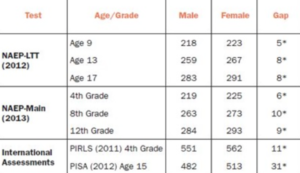 As long as there have been studies examining student achievement, it seems that girls have always outscored boys on reading assessments. Since the first National Assessment of Educational Progress (NAEP) was released 1971, the gender gap in reading has endured. The newest data - aggregated in a new report by the Brown Center on American Education - still shows that girls are outscoring boys, but the gap is narrowing.
As long as there have been studies examining student achievement, it seems that girls have always outscored boys on reading assessments. Since the first National Assessment of Educational Progress (NAEP) was released 1971, the gender gap in reading has endured. The newest data - aggregated in a new report by the Brown Center on American Education - still shows that girls are outscoring boys, but the gap is narrowing.
 U.S. Gender Gap in Literacy - Results from Eight Tests (Source: Brown Center for Education)
U.S. Gender Gap in Literacy - Results from Eight Tests (Source: Brown Center for Education)
Click to Enlarge
The report looks at eight different reading assessments, including international tests, and the margin between boys and girls has decreased on almost every measure, usually by statistically significant margins. Tom Loveless, the report's author, found that on the NAEP Long Term Trend, the gender reading gap shrank in all age groups since 1971. At age nine, for example, the gap on the assessment declined from 13 points in 1971 to 5 points in 2012.
Still, the reading gap persists, but why? Loveless points to three possible explanations. Girls could be "hardwired" for literacy better than boys. Secondly, he points to "cultural cues" in many countries that communicate to boys that reading isn't a masculine activity. Or maybe schools could be doing more to help boys perform better.
"But what scrambles the deck," Loveless adds, "is that we have adult tests in reading. And on those tests, the gender gap in reading doesn't exist. By the time of adulthood, it's evaporated. This is something that any of the casual explanations should somehow incorporate."
The gender reading gap is also a worldwide phenomonen. On the latest PISA results, 15-year-old females outperformed boys in all 65 participating nations. The 31 point gap in the United States doesn't even come close to being the largest. The country with the widest gap? Finland. In this top-performing country, girls outscore boys by an impressive 62 points.
In fact, says Loveless, "if we only looked at boys' reading scores, Finland's performance on PISA would be quite mediocre."
Video: Girls, Boys, and Reading








